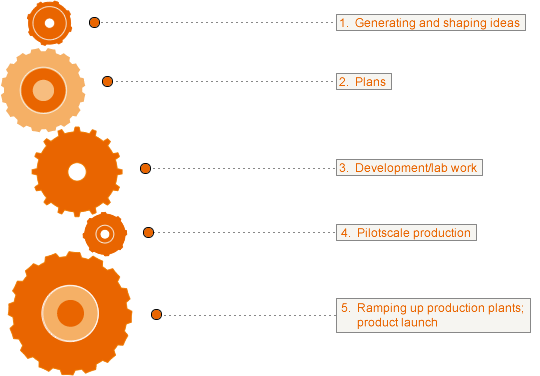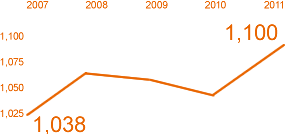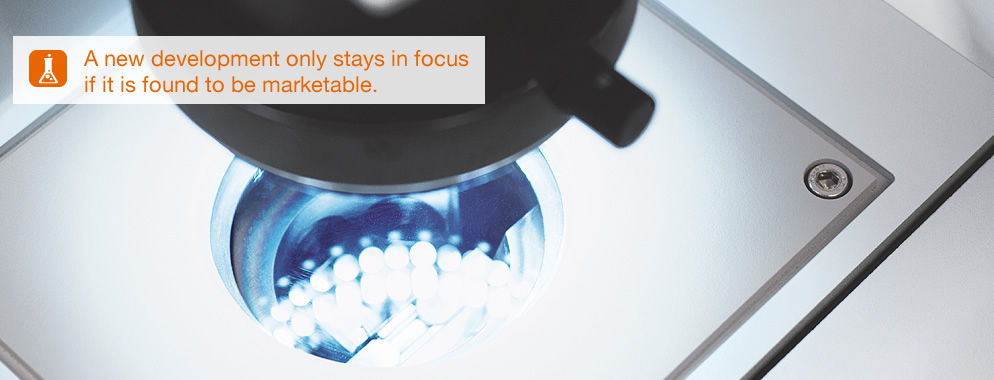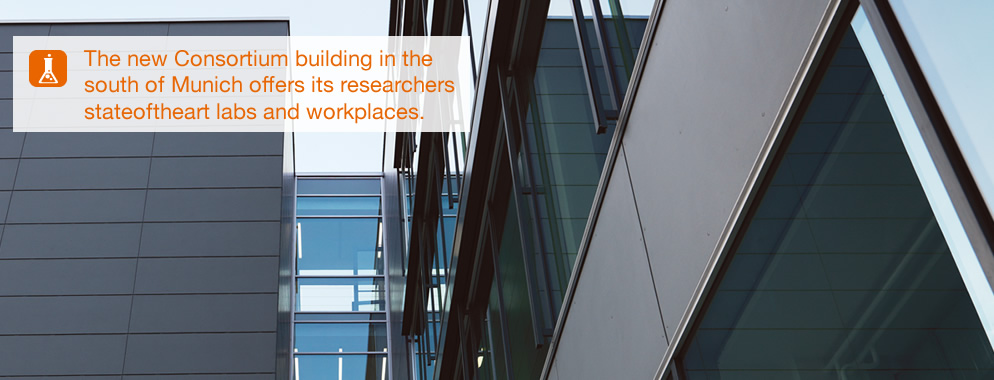
Innovation Management
Dr. Stary, can you control creativity?
If you are referring to the creativity of individual researchers – no, you can’t control it or steer it. That said, we can certainly direct the collective creativity of our 1,000 researchers. But it’s not as if we go around asking: who’s got the best idea today? Our employees work on clearly defined projects and, here, creativity can definitely be nudged in the right direction. Systematically conducted R&D is a steady source of growth for WACKER.
Who determines what the researchers in your laboratories work on?
Our everyday work stems from the project portfolio which our innovation strategy has identified. Before we start a new project, we evaluate it in terms of technology position, potential sales and profitability. That also means that all our projects are in competition with each other.
What is your role in all this?
The most important decision is to tackle the right projects with the right resources at the right time. Our innovation budget may be relatively high for a chemical company at 3.5 percent of sales, but it can’t be extended indefinitely. We can’t do everything. So, if our budget is fixed and we want to translate more of our ideas into market successes, we need to choose well and provide targeted funding.
Does that mean spending plenty of money on just a few projects?
Creativity can very easily be steered in the right direction. Systematically conducted R&D is an important source of growth for WACKER.
I wouldn’t put it like that. But focus certainly takes precedence over diversification. This means that we are concentrating even more on our key strategic projects. The chief goals here are to further improve our existing product platforms and production processes. These key projects consume around one-fourth of our R&D budget. However, we also look to important future trends that we can target with our technological expertise, such as photovoltaics and electricity storage. Focusing also entails drawing a line under old projects that have no prospect of economic success. That’s not as easy as it seems. Employees are passionate about their own projects, after all. So, we must exercise maximum objectivity and transparency when making our decisions.
Does that mean frustration is part of being a researcher?
I’d be more inclined to say that we are all at risk of having our projects shelved. It’s not a question of failure, it’s just life. In fact, for me it’s more a sign of strength when someone has the courage to say: I can’t go any further with this.
Especially since the speed of research has picked up, too...
That’s right. Up until a few years ago, developers were not under as much pressure. But they are now, because when the market sees really good solutions it wants them immediately. What’s more, we have to be constantly in tune with the demands both of technologies and customers. Such a situation arises for instance when a leading chip manufacturer dictates when and in what quality a new generation of wafers must be ready. The same goes for electromobility, where we’re helping to develop third-generation batteries. An industrially feasible solution must be ready by 2014. If we’re not ready by then, no-one will wait for us. There’s no point producing the ultimate solution a year later. See Focus Innovation
WACKER has now appointed technology managers to monitor areas that will be crucial in the future, such as electromobility. What is their task?
The technology managers monitor the technologies and markets of the future. They must become thoroughly conversant with all the technical and economic aspects of these technologies and be able to evaluate them. They identify users’ requirements and match them with our specific capacity to deliver a solution. They build up partnerships, form networks and also have an overview of all internal projects related to that area. A technology manager is a kind of marketing manager for new technologies. So, even before we invest a single euro in research, we know fairly exactly what our solution must look like and what its potential is.
What are the future technologies that the technology managers oversee?
Aside from electricity storage and electromobility, we are currently focusing on concentrated solar power plants, or CSP for short. These use, for example, parabolic mirrors to concentrate the rays of the sun. This concentrated heat energy is transferred to a steam circuit to generate electricity, as in conventional power plants. The heat-transfer fluid employed here must remain stable at very high temperatures. Within the last few months, we have developed and are currently testing a silicone-based prototype of one such fluid. The potential is huge. A power plant requires up to 8,000 metric tons of heat-transfer fluid. Without the technology manager, we would never have been so focused and progressed so quickly.
What would have happened in the past?
Innovation Management Means Backing the Right Idea.
In the past, we used to develop properties and then search for a market. And then we were sometimes disappointed that customers failed to appreciate our innovation. This was because we ignored the fact that our customers always expect new solutions to benefit them economically.
So should developers preferably also have studied business administration?
Technical or scientific training clearly takes priority, but we want developers to deal with the economic aspects from the start. We need researchers who are creative in searching for new molecules but their objective must always be to devise a solution that is technically and economically superior and can be sold on the market. Except for the area of basic research, we don’t draw up plans today for things that we can’t sell tomorrow. See Product Innovation
But that doesn’t apply just to new products...
That’s right. It’s true that one-fourth of our sales come from new products. But we must further expand our existing business. Our goal here is to make processes better and cheaper. And this is an area of collaboration between Corporate R&D, the business divisions and technical service managers.
Can you give a specific example?
Take polysilicon for the solar industry. Every day you read how tough the competition is. We, too, can only do good business if our cost position is better than that of our competitors. How can we achieve that? By having a fully closed loop in the case of silicon, for example. There is still scope for optimizing the yield of material. The goal is zero waste. And we are working on boosting the energy efficiency of silicon deposition. Innovations of this kind can help us to thrive even in this fiercely competitive market.
WACKER operates in global markets. How international does research and development have to be here?
Some 800 of our roughly 1,000 R&D employees work in Germany. Nevertheless, research is swiftly becoming internationalized. In our local technical centers in China, India and Brazil, products are being adapted to the local market. This generates ideas for basic research. In other countries, creativity manifests itself differently. Other nationalities often have a more pragmatic approach, and that is good. In India, for example, a researcher at one of our joint ventures used raw materials from Germany to create a silicone emulsion for hair rinses, which will now be used around the world. This shows that the German solution is not always the best. See Process Innovation
Is this also a step toward global recruiting?
Naturally, local networks spring up on account of our technical centers. We get to know the local scene and that enables us to be selective in our recruiting. In Germany, our reputation still enables us to choose the very best – experts who know that we live for innovation.
A strong claim. Can you back it up?
Last June, for example, WACKER received the Best-Innovator-Award. The jury highlighted the fact that thinking and acting innovatively are firmly embedded across the company. At WACKER, everyone from the Executive Board right down through all management levels has an understanding of the matter. And that makes a difference, you know, when you not only have a strategy for innovation, but also want to implement it.
Characteristics
|
3.5%of our sales revenue is invested in R&D. |
24%of our sales revenue was achieved with new products in 2011. |
Outstanding Research
- The “Thomson Reuters 2011 Top 100 Global Innovator Award” distinguished WACKER as one of the most innovative companies in the world. WACKER received the award for its outstanding innovation and patents.
- WACKER received Germany’s 2011 Best Innovator Award in the Chemical category for its sustainable innovation management. A.T. Kearney and German business weekly “WirtschaftsWoche” organized the competition, in which more than 100 companies participated.
Stages in the Innovation Process

5-Year Comparison of Employees in R&D
|
179researchers have entered for the Alexander Wacker Innovation Award since 2006. |






